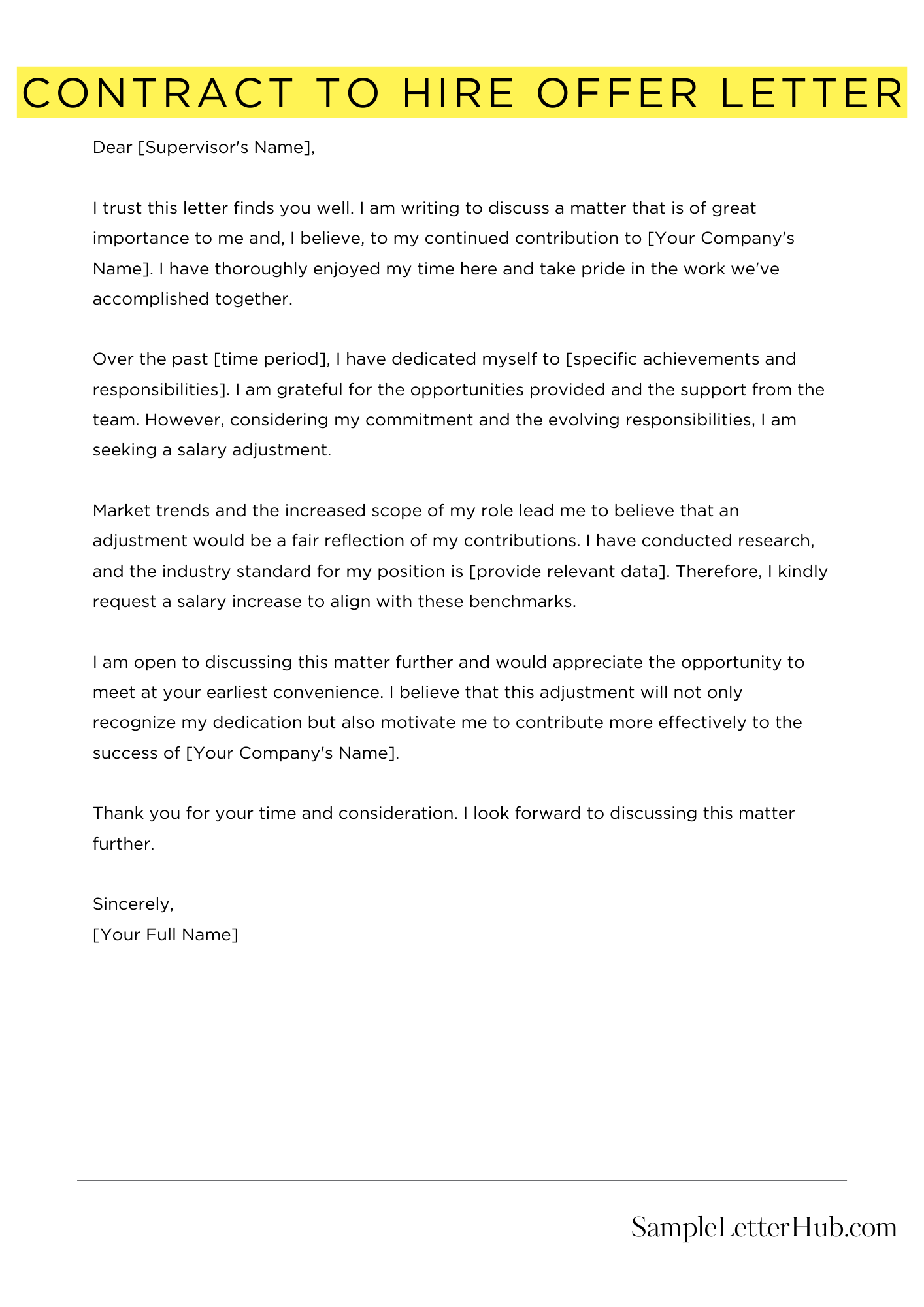A Contract To Hire Offer Letter is a legal document that outlines the terms of an employment offer between an employer and a potential employee. It is a binding agreement that sets forth the expectations and responsibilities of both parties.
In this article, we will provide you with templates, examples, and samples of Contract To Hire Offer Letters. These resources will help you to create a professional and legally binding offer letter that will protect your interests and the interests of your potential employee.
By using our templates and samples, you can save time and ensure that your offer letter is compliant with all applicable laws.
Contract to Hire Offer Letter
Dear [Recipient Name],
We are pleased to extend a contract to hire offer for the position of [Position Name] at [Company Name]. This offer is contingent upon the successful completion of a background check and drug screening.
Your employment will commence on [Start Date] and will be for a period of [Contract Duration]. During this period, you will be considered a contractor and will not be eligible for benefits.
Your responsibilities will include:
* [List of responsibilities]
Your compensation will be [Amount] per [Time Period]. You will also be eligible for [Benefits].
We believe that your skills and experience will be a valuable asset to our team. We look forward to working with you and contributing to your professional growth.
To accept this offer, please sign and return a copy of this letter by [Date]. If you have any questions, please do not hesitate to contact us.
Sincerely,
[Your Name]

How to Write a Contract To Hire Offer Letter
A contract to hire offer letter is a legally binding agreement between an employer and a prospective employee. It outlines the terms of employment, including the job title, salary, benefits, and start date. It is important to carefully review a contract to hire offer letter before signing it, as it will be legally binding once signed.
Essential Elements of a Contract To Hire Offer Letter
A contract to hire offer letter should include the following essential elements:
- The name and address of the employer
- The name and address of the prospective employee
- The job title
- The salary
- The benefits
- The start date
- The signature of both the employer and the prospective employee
Negotiating the Terms of a Contract To Hire Offer Letter
It is important to carefully review the terms of a contract to hire offer letter before signing it. You should make sure that you understand all of the terms and that you are comfortable with them. If you have any questions about the terms of the offer letter, you should ask the employer for clarification.
You may also want to negotiate the terms of the offer letter. For example, you may be able to negotiate a higher salary or more benefits. However, it is important to be realistic in your negotiations. The employer is not likely to agree to terms that are unreasonable.
Signing a Contract To Hire Offer Letter
Once you have agreed to the terms of the offer letter, you should sign it and return it to the employer. The employer will then sign the offer letter and return it to you. The offer letter will then be legally binding.
It is important to keep a copy of the signed offer letter for your records. You should also make sure that you understand all of the terms of the offer letter and that you are comfortable with them before signing it.
Breaching a Contract To Hire Offer Letter
If either the employer or the prospective employee breaches the terms of a contract to hire offer letter, the other party may be able to sue for damages. For example, if the employer withdraws the offer after the prospective employee has accepted it, the prospective employee may be able to sue for breach of contract.
It is important to note that a contract to hire offer letter is not the same as an employment contract. An employment contract is a more comprehensive agreement that outlines the terms of employment in more detail. A contract to hire offer letter is simply an offer to employ someone. The prospective employee does not become an employee until they have signed an employment contract.
FAQs about Contract To Hire Offer Letter
What is a Contract To Hire Offer Letter?
A Contract To Hire Offer Letter is a legally binding agreement between an employer and a potential employee that outlines the terms of employment, including the job title, salary, benefits, and start date. It is typically used when an employer wants to hire a candidate on a temporary or contract basis, with the possibility of converting the position to a permanent role at a later date.
What are the key elements of a Contract To Hire Offer Letter?
The key elements of a Contract To Hire Offer Letter typically include the following:
- Job title and description
- Start date and end date (if applicable)
- Salary and benefits package
- Terms of employment, including probationary period and termination
- Confidentiality and non-compete agreements
What are the advantages of using a Contract To Hire Offer Letter?
There are several advantages to using a Contract To Hire Offer Letter, including:
- It provides a clear understanding of the terms of employment for both the employer and the employee.
- It helps to protect the employer from potential legal disputes.
- It can be used to attract and retain top talent.
What are the disadvantages of using a Contract To Hire Offer Letter?
There are also some potential disadvantages to using a Contract To Hire Offer Letter, including:
- It can be more time-consuming and expensive than a traditional offer letter.
- It may not be suitable for all types of employment situations.
- It can create a sense of uncertainty for the employee.
When should I use a Contract To Hire Offer Letter?
A Contract To Hire Offer Letter is typically used when an employer wants to hire a candidate on a temporary or contract basis, with the possibility of converting the position to a permanent role at a later date. It can also be used when an employer is unsure about the long-term viability of a position or when the employee is not yet fully qualified for a permanent role.

